
|
|

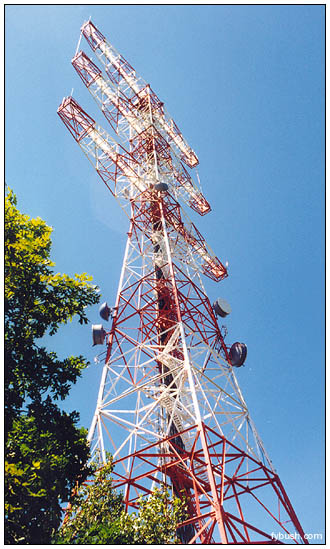 June 10, 2005
June 10, 2005
The Birthplace of FM Broadcasting, Alpine, N.J.
By SCOTT FYBUSH
(This is an update of a Site of the Week that originally appeared December 19, 2002.)
For the few years, I've been working on a book called The Airwaves of New York, Volume II, a sequel to the incredibly detailed The Airwaves of New York (McFarland & Co., 1998) by Bill Jaker, Frank Sulek and Peter Kanze. That book documented the history of 156 AM stations that have come and gone from the Big Apple airwaves over the last eighty years or so.
The new volume will track the history of the stations that have graced the New York FM dial over more than sixty years. That's meant plenty of time on the road, much of it heading from the cousins' home in Rockland County down to Manhattan by way of the Palisades Interstate Parkway and the George Washington Bridge.
There could be no more appropriate route to take, as it works out, because not long after passing the New York-New Jersey state line, drivers on the Palisades see an unusual tower poking up above the trees, with three big crossbeams carrying a small forest of antennas.
Most drivers probably don't pay much attention to this stick, but if you're reading this column and you've driven this road, odds are that you too have slowed down and gotten off the highway at exit 3 to get a better look at this magnificent piece of steel.
For it was right here, in the woods along Route 9W, that FM broadcasting as we know it was born in the late thirties, on a tower erected by none other than the inventor of FM radio, Major Edwin Howard Armstrong, born this very week 112 years ago in New York City.
Long before his invention of frequency modulation, Armstrong had already contributed immensely to the development of broadcasting; his invention of the regenerative circuit in 1912 and the superheterodyne receiver in 1917 made it possible to build the inexpensive, super-sensitive tube radios that began to appear in the early twenties and were soon household staples.
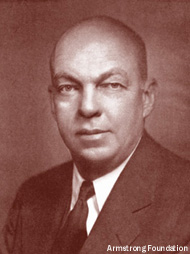 The
story has been told many times (see Lawrence Lessing's Man
of High Fidelity and Tom Lewis' Empire of the Air,
in particular) of the early friendship between Armstrong and
David Sarnoff, the head of RCA and founder of NBC, which began
when Armstrong demonstrated the superheterodyne receiver to Sarnoff
during a late-night DX session on the New Jersey coast.
The
story has been told many times (see Lawrence Lessing's Man
of High Fidelity and Tom Lewis' Empire of the Air,
in particular) of the early friendship between Armstrong and
David Sarnoff, the head of RCA and founder of NBC, which began
when Armstrong demonstrated the superheterodyne receiver to Sarnoff
during a late-night DX session on the New Jersey coast.
The legend tells, as well, of Sarnoff's challenge to Armstrong to develop "a little black box" that could eliminate the static that plagued AM broadcasting in those early years, a challenge that occupied Armstrong throughout the late twenties and early thirties, culminating in Armstrong's announcement to Sarnoff in 1933 that his "black box" was ready - a roomful of equipment that represented the first successful use of frequency modulation. It was obvious from the first that the new "FM" technology represented a vast improvement over the sound quality of existing broadcasts, offering much wider frequency response and the absence of the background noise that marred AM reception, especially in small towns and rural areas that lacked their own radio stations.
At first, Sarnoff and RCA encouraged Armstrong's research into FM, giving him space in their laboratories at the top of the Empire State Building to continue his work and experiment with FM transmission.
But the development of FM, particularly the ability to relay programming from city to city by direct off-air pickup (which Armstrong was demonstrating as early as 1936), posed a threat to NBC's domination of "conventional" radio - and in those Depression years, the challenge of selling a new broadcasting system to replace the already sizable existing base of receivers also made NBC nervous, particularly as it geared up for its impending launch of commercial television.
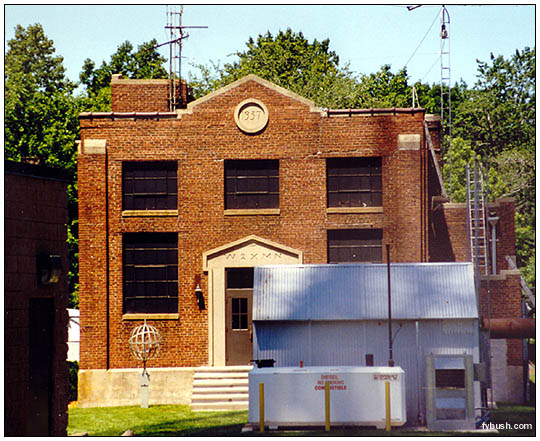 So
Sarnoff and RCA cut their ties with Armstrong, exiling him from
the Empire State Building and removing his chief source of funding.
So
Sarnoff and RCA cut their ties with Armstrong, exiling him from
the Empire State Building and removing his chief source of funding.
Locked out of the highest point in New York City, Armstrong returned to his family home in Yonkers and looked across the Hudson River to the towering New Jersey Palisades on the other side.
In early 1937, he bought land in what was then an undeveloped area along Route 9W, a spot that provided an excellent view to the south from more than 500 feet above sea level, over the new George Washington Bridge and into Manhattan.
Never afraid of heights, Armstrong went to work building a 400-foot tower in a clearing in the woods that lined 9W (the Palisades Parkway was still more than a decade in the future). With an eye toward future development, Armstrong made sure his new tower would have plenty of room for antennas, designing the three-arm configuration that remains a unique feature of the Alpine tower even today. At the base of the tower, he built a two-story brick building to house his transmitter, embossing his call letters, W2XMN, in the concrete above the door. Along both sides of the steps leading to the building, he placed small replicas of the metal globe that sat atop Aeolian Hall in Manhattan, the RCA facility where he had famously been photographed in the twenties perching precariously on one foot, high in the air.
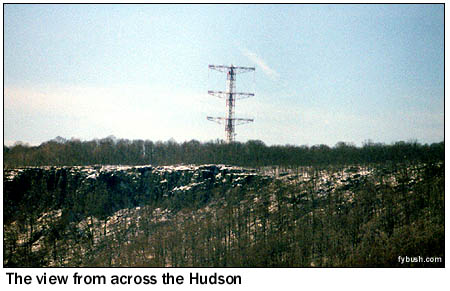 Within
months, the tower was carrying W2XMN's signal out over the New
York metropolitan area and beyond; on the old 42-50 MHz FM band,
summertime skip in 1938 produced regular static-free reception
at the eastern tip of Long Island and, at least once, down as
far as Virginia.
Within
months, the tower was carrying W2XMN's signal out over the New
York metropolitan area and beyond; on the old 42-50 MHz FM band,
summertime skip in 1938 produced regular static-free reception
at the eastern tip of Long Island and, at least once, down as
far as Virginia.
The signals from W2XMN were also being picked up in Connecticut at West Peak in Meriden, where Armstrong was working with Franklin Doolittle's WDRC and John Shepard's Yankee Network to build a network of FM relays that would eventually stretch north all the way to Mount Washington, New Hampshire.
But the advent of World War II stalled both FM and TV (though Armstrong's FM system would see wide use for military communication, where it soon became the standard), and when the war ended, the industry's attention was fixed on the introduction of television, a medium many thought would replace radio completely. RCA attempted to further delay FM by leading a charge to move FM stations out of the 42-50 MHz band and up the dial to 88-108 MHz. While history would eventually prove that to be a wise move (it created more than twice as many FM channels as had been possible in the old band and eliminated the nearly-regular skip that would have plagued local FM reception in the summer), it had the unfortunate effect of rendering existing FM radios useless and raising consumers' doubts about the long-term viability of FM.
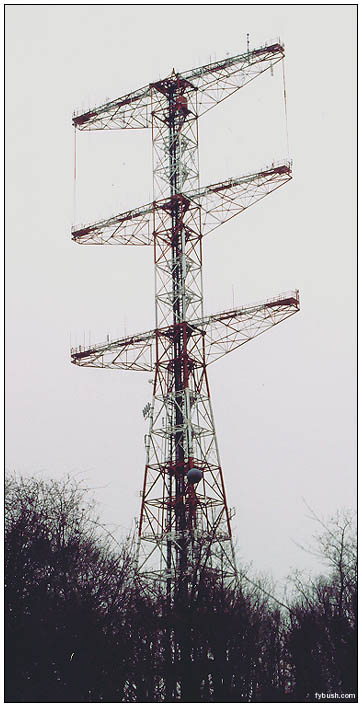 Armstrong
himself, meanwhile, found himself embroiled in a patent dispute
with RCA. While the FCC had handed Armstrong a victory by choosing
FM as the audio standard for television in 1941, RCA was unwilling
to meet Armstrong's demands for royalties on the use of his FM
patents in RCA's TV transmitters and receivers.
Armstrong
himself, meanwhile, found himself embroiled in a patent dispute
with RCA. While the FCC had handed Armstrong a victory by choosing
FM as the audio standard for television in 1941, RCA was unwilling
to meet Armstrong's demands for royalties on the use of his FM
patents in RCA's TV transmitters and receivers.
Always a stubborn man, Armstrong became obsessed with the lawsuit against RCA, refusing settlement offers and devoting all of his energy to fighting the radio giant in court. The pressure eventually became too much for him to bear, and on February 1, 1954, Armstrong stepped out of the thirteenth-floor window of his New York apartment to his death.
Across the Hudson, his radio station had remained active all those years, under the calls KE2XCC and later WFMN (although it's unclear that the latter call was actually used on the air), moving to 93.1 MHz after the old FM band was vacated. On March 31, 1954, Armstrong's staffers turned it off for the last time, and the tower went silent.
While Armstrong himself was largely forgotten, even by many in the radio community, in the years that followed, his tower remained standing as a legacy to his engineering skills. It began to attract various non-broadcast users, and in 1971 it again became home to an FM transmitter, WFDU (89.1 Teaneck), the broadcast outlet of Fairleigh Dickinson University.
By 2001, the tower had become a fixture in the New York radio spectrum, playing host to a wide variety of two-way users, cellular and PCS antennas, satellite uplink/downlink facilities and television ENG (electronic newsgathering) receivers.
And then, on September 11, Alpine returned to the headlines. With the destruction of the World Trade Center, the television stations that lost their transmitters needed an alternate location that would give them usable coverage of New York City and already offered the infrastructure needed to get back on the air quickly.
All of Armstrong's foresight more than 65 years earlier, combined with the investment current tower owner CSC Management had made in state-of-the-art facilities at the tower's base, made the Alpine tower a natural choice for several stations. Within a week of the attack, Alpine was on the air with TV signals, ultimately playing host to WNBC (Channel 4), WABC-TV (Channel 7), WPIX (Channel 11), WNET (Channel 13) and WNJU (Channel 47) over the year that followed.
Those who remembered the story of Edwin Howard Armstrong and his battles with RCA surely appreciated the irony in WNBC's use of the tower; the station is the descendant of W2XBS, the RCA experimental TV station that ousted Armstrong from the Empire State Building all those decades ago. (You can read more about the fascinating story of the New York stations' return to the air in our special issue of NorthEast Radio Watch, "9/11 Plus One.")
You might think, after reading about all the history of this magnificent site, that the fine people of Alpine, New Jersey would appreciate that they have in their midst one of the true landmarks of American broadcasting history. (You might even think that Armstrong's tower deserves landmark status of some sort, and we'd be the first to sign on to such a campaign.)
Alas, a visit to Alpine these days will show you that the pristine forest that surrounded this site when Armstrong began building in 1937 has given way to million-dollar McMansions, occupied in no small number by the sort of people who seemed surprised to suddenly realize that there was a radio tower - a big, painted, lit radio tower - there in the backyard of the home they'd just built in, say, 1994. That, in turn, has meant vocal, well-funded opposition to CSC's proposals to improve the Alpine Tower to provide higher-powered auxiliary capabilities for television broadcasters in the event they again lose their Manhattan signals. Check out the neighbors' Web site - and note that this "grassroots" group is asking for an average contribution of $2500 per household! "NIMBY," indeed... (You can keep reading, if you're so inclined, for unfounded assertions that digital TV is somehow "believed to cause much greater health risks, and in a wider area, than traditional broadcasting" and that "there are very few towers of this type in all of America located in residential areas[*].")
But never mind the neighbors; the next time you turn on your FM radio, stop and give a thought to Edwin Howard Armstrong, one of the true heroes of American broadcasting, and to his steel legacy high above the Palisades.
[* - The Alpine neighbors might want to take their $2500 and spend it on visits to Boston, Providence, Philadelphia, Rochester, Pittsburgh, Detroit, Washington, Kansas City, Seattle and San Francisco, just to name a few of the "very few" communities in America that have high-powered TV transmission facilities in decidedly residential areas. Or perhaps when they say "towers of this type" they mean the unique three-arm design, in which case there are simply no other towers of this type located in any area, residential or otherwise, anywhere in the country. And as for their concerns about the effect of the tower on real estate values, a quick search shows that the least expensive single-family home currently listed for sale anywhere in Alpine is a bargain at $675,000, far below the average sale price of more than $2.8 million - and this on a housing stock whose average age is 14 years! (Again, that tower's been in town for 65 years now...)]
2005 UPDATE: We present this encore Tower Site of the Week in honor of this weekend's commemorative broadcast from Alpine, marking the 70th anniversary of Major Armstrong's earliest FM broadcasts. Listeners in the New York metropolitan area (and even beyond) should check out 42.8 MHz on Saturday, June 10, starting at noon, to hear WA2XMN, a special experimental transmission honoring Armstrong and his work. The broadcast will be simulcast on WFDU 89.1, and will be streaming on WFDU's website as well.
CSC Management and the Sackerman family have done an excellent job maintaining their piece of broadcast history, and it's gratifying to be able to report that the threats from the neighbors appear to have subsided; the neighbors' website hasn't been updated in ages, and the message board on the site seems to have been discovered by many fans of Major Armstrong, too! (The webcam on the site remains active, though, so don't hesitate to go visit, anyway.
Oh, and as for the deleterious effects of that big radio tower on Alpine real estate values? Forbes magazine listed the community as the eighth most expensive in the nation on its list of "The Most Expensive Zip Codes 2005," with a median 2004 sale price of $1.773 million. (Alpine didn't even make the list in 2003.) One home in town sold for over $4.8 million in 2004. If that's what the tower does to real estate values, I want one in my back yard. (Okay, I want one in my back yard anyway, but, well...)
We're on the road this week gathering new Sites of the Week, including a stop at the Armstrong commemoration. We'll be back with a new site June 17th!
It's here - the 2005 Tower Site Calendar is now available at special clearance prices! Click here for ordering information!
- Previous Site of the Week: WMCA/WNYC, Kearny, N.J.
- Next Week: TBA
- Site of the Week INDEX!
- How can you help support Site of the Week? Click here!
- Submit your suggestions for a future Site of the Week!
